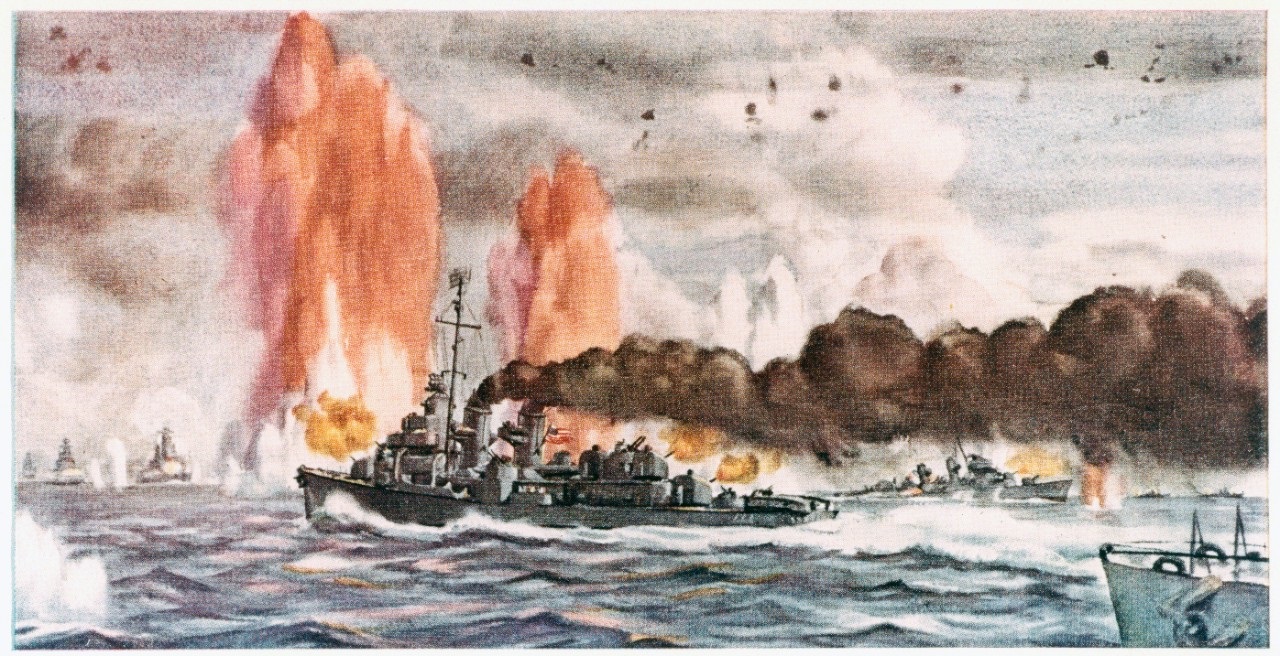October 25th, 1944. In all the long and illustrious history of the United States Navy, no date is more glorious. While covering the first US landings in the Philippines, escort carrier group Taffy 3, consisting of 6 escort carriers, 3 destroyers and 4 destroyer escorts, found itself facing down the might of the Imperial Japanese Navy. Thanks to a series of errors, a force of four battleships, eight cruisers and eleven destroyers had slipped through the covering force and was bearing down on the invasion beach.1

Faced with these overwhelming odds, the men of Taffy 3 fought back. The text of their Presidential Unit Citation says it better than I could:2
For extraordinary heroism in action against powerful units of the Japanese Fleet during the Battle off Samar, Philippines, October 25, 1944. Silhouetted against the dawn as the Central Japanese Force steamed through San Bernardino Strait towards Leyte Gulf, Task Unit 77.4.3 was suddenly taken under attack by hostile cruisers on its port hand, destroyers on the starboard and battleships from the rear. Quickly laying down a heavy smoke screen, the gallant ships of the Task Unit waged battle fiercely against the superior speed and fire power of the advancing enemy, swiftly launching and rearming aircraft and violently zigzagging in protection of vessels stricken by hostile armor-piercing shells, anti-personnel projectiles and suicide bombers. With one carrier of the group sunk, others badly damaged and squadron aircraft courageously coordinating in the attacks by making dry runs over the enemy Fleet as the Japanese relentlessly closed in for the kill, two of the Unit's valiant destroyers and one destroyer escort charged the battleships point-blank and, expending their last torpedoes in desperate defense of the entire group, went down under the enemy's heavy shells as a climax to two and one half hours of sustained and furious combat. The courageous determination and the superb teamwork of the officers and men who fought the embarked planes and who manned the ships of Task Unit 77.4.3 were instrumental in effecting the retirement of a hostile force threatening our Leyte invasion operations and were in keeping with the highest traditions of the United States Naval Service.
More direct are the words of the captain of one of the destroyers sunk during the battle, Commander Leon Kintberger of the USS Hoel. "Fully cognizant of the inevitable result of engaging such vastly superior forces, these men performed their assigned duties coolly and efficiently until their ship was shot from under them."

Bob DeSpain in Iowa's wardroom3
I knew one of those men. Bob DeSpain was a 17-year old gunner on the Hoel who volunteered at the Iowa before he passed away last year. I got goosebumps every time I met him. He would sit in the wardroom and talk to guests. He sold copies of James Hornfisher's book, Last Stand of the Tin Can Sailors. He'd sign by his picture. I have a copy, and it's one of my most treasured books. He was the nicest man, and I always made sure to ask if he needed help getting set up or getting more books from the store. He once told me that there was so much blood on the deck that when he got knocked down, he thought he'd been hit. But usually, his stories were of lighter things. He told me about flirting with the nurses in the hospital after they fished him out of the Pacific. We talked about Farragut Naval Training Station in Idaho, where he'd done basic training, and which I'd visited. I am still amazed that I had the honor to get to know him. We all miss him.
1 I intend to give a full account of Leyte Gulf at some point, but it's going to be a project that rivals the Jutland series. There's a shorter version here. ⇑
2 The PUC is the highest award for valor given to a unit, as opposed to an individual. It's considered equivalent to a Navy Cross, which ranks just below the Medal of Honor. ⇑
3 Photo from TripAdvisor, because I forgot to get one of my own. ⇑

Comments
Just to make clear the disparity of forces, Taffy 3's entire escort group totaled 12,900 tons full load, 1270 lbs weight of broadside, and 30 torpedoes. The smallest of the six IJN heavy cruisers present, was 13,670 tons, 3076 lbs weight of broadside, and 24 vastly superior torpedoes. And then there were the four battleships, one of which roughly matched all six cruisers combined.